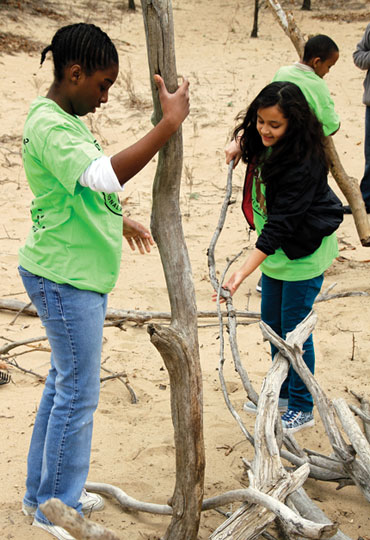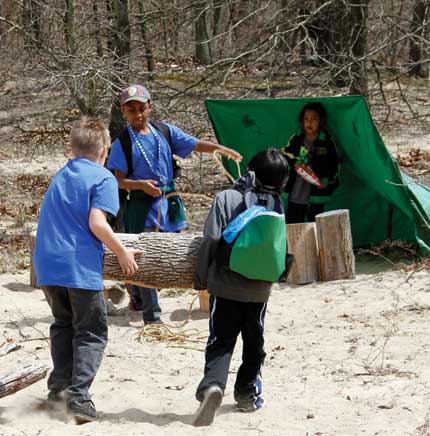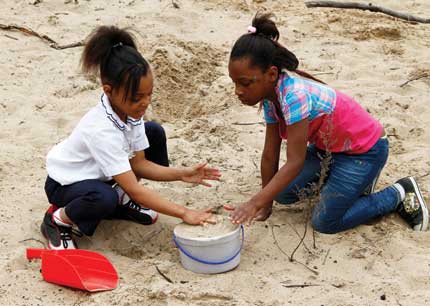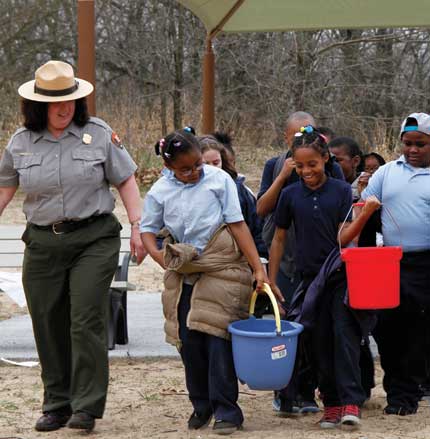Introduction

NPS PHOTO COLLECTION/KATRINA GEORGE
It is a gorgeous June day at Indiana Dunes National Lakeshore, and I am watching several families enjoying the park (see photos throughout this article). One group is standing around a young oak tree looking up at two young girls scurrying up the branches like a couple of squirrels. Their mom turns to me and says, “I didn’t even know they knew how to climb a tree.” Another group is playing in the sand, hiding rocks, digging up others, and exclaiming with joy as if they just found gold. A third group is building a small fort, laying an intricate pattern of sticks and driftwood around a larger trunk they have inserted into the ground. The older sibling is helping the younger one in a rare display of cooperation, according to their dad. In another park location, these would all be ticketable offenses, and I would be going out to chide the parents and wrangle the kids back onto a trail or to a picnic area. However, these are just the sort of park interactions we are seeking at our new Nature Play Zone, so I just smile and watch.
We have been witnessing and facilitating this kind of behavior in kids since we started testing the play area in April 2012, and we could not have asked for a better response. It all started with Richard Louv’s 2008 book, Last Child in the Woods. Several of us on staff read his book, including our park superintendent, Constantine Dillon, who approached the interpretive staff and suggested we initiate an unstructured play area similar to what Louv describes. First, we visited other nature centers to see their play areas. We found some excellent examples and were inspired by the range of options, from the highly developed Hamill Family Play Zoo at Brookfield Zoo to the Wild Place at Lyman Woods, which is just a roped-off section of meadow and woods behind the nature center.
Site criteria and description

NPS PHOTO COLLECTION/JEFF MANUSZAK
We started by looking for a good spot at the national lakeshore. We wanted an area where staff could interact with participants regularly, so it had to be near a staffed site with parking. We needed a place that was already developed or disturbed. We did not want to open up a new area of the park, and it could not be in endangered species habitat. We manage for both the federally protected Karner blue butterfly and the federally threatened Pitcher’s thistle. So we had to do some vegetation sampling at any potential site to be sure these plants were not present. Luckily, as we were doing a park cleanup near the Paul H. Douglas Center for Environmental Education, the park’s primary education facility, we stumbled upon a site that met all three criteria: near parking and a staffed site, no sensitive species, and previously disturbed, as it was a railroad junction about 50 years ago.
It was really pretty easy after that. We worked with a high school group to sample the vegetation of the area and identify what was growing there. We cleaned up the site, removing trash, glass, and debris. We did the necessary archeological compliance work and put the project onto the Planning, Environment, and Public Comment Web site for feedback. The area previously had been cleared for archeology when the parking lot was first constructed. We removed invasive species such as oriental bittersweet, black locust, and tree of heaven, again with the help of volunteers and student groups.
Once the compliance process was complete and we received a green light, we set up a pilot program. The first big obstacle popped up in early spring in the shape of three leaves—poison ivy, very serious poison ivy. At first, we thought we could just leave it and post signs, identifying the plant species for visitors. We realized, as the full spring growth erupted, that the area was thick with the itchy, native plant. So we worked with resource management to use low-grade herbicide to remove larger patches of it. We did leave a small patch and have signs showing folks what it looks like.
The vegetation at our Nature Play Zone is primarily dune grasses, grapevines, small oaks, and cottonwood trees, with some interesting native species coming in at different times of the year. Prickly pear cactus is one of the favorites of the kids. Even though it has some safety issues, we have decided to leave it and allow children to learn “the hard way” how to explore it. Unlike poison ivy, there is an immediate cause-and-effect reaction to touching cactus. We have not had any complaints, and visitors seem excited to find it nestled among the grasses. Horsetail is another fun plant that grows profusely in the play area and can be manipulated and made into a play item for the kids without damaging the plant seriously. We created a plant scavenger hunt for children to try to find as many of the common plants as they can in the area, which adds an educational element to their visit.
Lessons learned from the pilot program

NPS PHOTO COLLECTION/KATRINA GEORGE
That first summer of testing provided excellent feedback for our team. We set up an unobtrusive observation form for staff to use when they brought families to the area. We learned which activities children preferred and which areas of the play zone were their favorites. We also watched the adults and how they interacted with the students, and we quickly learned that the way adults react directly correlates with how students behave in the area. When the adults are relaxed and get involved, even in a small way, the children respond positively. If children sense the adults are not comfortable and are going to get upset if they get dirty, then they react differently, quarreling with one another, resorting to traditional playground behavior, and being less willing to experiment. Exploring and experimenting are the behaviors we want to see at this new space. When kids are given that freedom, their imaginations kick into gear and the magic of nature happens. Time seems to slow down here, and they forget about electronic devices and TV shows and just play.
Nature play looks different than traditional playground play. It is inquiry-oriented, with kids asking questions and finding answers on their own or with the help of adults or other kids. They build elaborate nests, forts, and designs. They cooperate with each other and try new things all because the boundaries and spare parts are loose and can be manipulated. They explore and search for the six-lined racerunner lizards that dart between the rocks. They dance with the wildflowers and just sit by themselves making castles with rocks. It feels so good to watch this kind of play, especially in our area, a middle-class neighborhood of Gary, Indiana, where these types of play areas are nonexistent and even playgrounds are few and far between. It is accessible to thousands of local residents who can walk, ride bikes, or take public buses to the play area, which is part of the Douglas Center for Environmental Education and open for indoor nature activities.
Nature play looks different than traditional playground play. It is inquiry-oriented, with kids asking questions and finding answers on their own or with the help of adults or other kids.

NPS PHOTO COLLECTION/KATRINA GEORGE
Several adults who brought children to the first pilot programs at the play area suggested that a shade structure be erected since the area is open to the sun and elements. Fortunately, the National Park Service provided the funding for this through its Healthy Parks Healthy People initiative. We contracted for an innovative shade shelter and used green paving materials to make a pavilion and walkway that are accessible for strollers and wheelchairs.
In addition to the structure at the play area, the park initiated a Nature in My Neighborhood campaign to coincide with the opening of the Nature Play Zone. In the hopes of inspiring and cultivating nature play at home, we are providing free nature backpack kits to the first 1,000 families who visit the Nature Play Zone this spring and summer. The backpacks provide tools such as binoculars, journals, and a field guide for children to continue nature exploration on their own. Additional funding for this program came from the park’s partner, the Dunes National Park Association, who helped us kick off the opening in April 2013.
Positive response
Since that grand opening, the play area has hosted more than 1,000 children. The response has been overwhelmingly positive from the public and the park staff who facilitate play. Based on this initial success and research on the benefits of nature play, we believe the benefits of unstructured nature play in a national park are far-reaching and can be achieved with minimal disturbance. However, while anecdotal evidence is positive to date, we must also continue to evaluate use of the site by observing children at play, monitoring vegetation, and looking for signs of increased impacts on other areas that might be resulting from the freedoms allowed in the play zone. We have posted an orientation panel at the play area, explaining that this site has different rules than other areas of the park, but we all know signs are limited in their effectiveness. In addition to these direct effects of the play zone, we would like to work with researchers to measure more long-term, qualitative effects of exposure to this type of play in nature and how the smiles and laughter we see so prevalently might translate into creating future stewards of our national parks.
Author information
—Kim Swift (kimberly_swift[at]nps.gov) is Education Programs manager at Indiana Dunes National Lakeshore, Indiana.
Tags
Last updated: March 2, 2016
